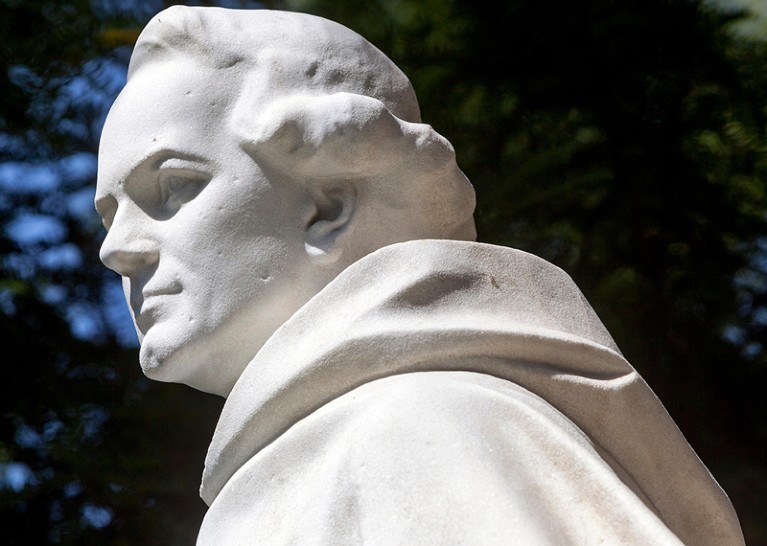
Mendel showed that flower colour in pea plants can be inherited. The flower in the centre is a cross between the pink flower and the white flower.Credit: Oxford Science Archive/Print Collector/Getty
Genetics is fiendishly complex. We know this from decades of molecular biology, from the resulting studies on the sequencing and analysis of genomes and from our increasing knowledge of how genes interact with the environment. So how did the Augustinian friar, teacher and citizen scientist Gregor Mendel manage to describe principles of inheritance that still stand today — from work he performed alone in his monastery garden in the 1850s and 1860s?
Many of the details have been lost to history, because notes of Mendel’s experiments, including his interim observations and his working methods, were burnt after his death, as Kim Nasmyth at the University of Oxford, UK, describes in a Perspective article in Nature Reviews Genetics1.
But from his published works, as well as historical sources that have recently come to light, it’s clear that Mendel was a careful scientist; cautious, patient and committed to data. These qualities allowed him to make discoveries that have stood the test of time. The 200th anniversary of his birth on 22 July 1822 provides an opportunity to celebrate and recognize a giant in science. “Viewed in the light of what was known of cells in the mid-nineteenth century, Mendel was decades ahead of his time,” write Peter van Dijk at KeyGene in Wageningen, the Netherlands, and his colleagues in a Perspective article in Nature Genetics2.
Model communication
Although Mendel had no knowledge of genes, chromosomes or genomes, he laid the foundations for genetics in a paper, ‘Experiments on plant hybrids’, which he presented to the Natural History Society of Brno (now in the Czech Republic) in 18653. Starting with 22 plants of the garden pea, Pisum sativum, and using manual pollination, Mendel crossbred these specimens and their progeny multiple times, producing more than 10,000 plants over 8 years. Plants from each pollination cycle were classified according to various characteristics, such as the colour and shape of the seeds and the position of flowers. By analysing these data, Mendel discovered that certain traits — shape and colour, for example — can be passed down from one generation to the next.
How did Mendel arrive at his discoveries?
The paper is a model for research communication. It describes, in accessible language, how Mendel established controls and protected the integrity of his experiments (such as taking steps to reduce the risk of wind-blown or insect pollination). He is generous in crediting others’ work on the subject. The final part of the manuscript includes a discussion of caveats and potential sources of error. “The validity of the set of laws suggested for Pisum requires additional confirmation and thus a repetition of at least the more important experiments would be desirable,” Mendel writes in the conclusion.
Although in his paper he did coin the terms ‘dominant’ and ‘recessive’ — which remain fundamental concepts in genetics today — Mendel’s caution in interpreting his results proved well-founded. Generations of geneticists and molecular and structural biologists have since demonstrated that observable characteristics do not result from genes alone. By working with model organisms and studying familial diseases and human populations, scientists have shown time and again that characteristics are influenced by an intricate interplay between a host of factors. These include RNA, epigenetics (chemical alterations to DNA bases that don’t change the DNA sequence), the position of a gene within both the genome and the nucleus of a cell, and how all of the above interact with environmental factors.

A statue of Gregor Mendel in the Abbey of St Thomas in Brno, Czech Republic, where Mendel was abbot.Credit: Alamy
And yet, as has been well documented, Mendel’s name was wrongly and irresponsibly appropriated to give weight to eugenics, the scientifically inaccurate idea that humans can be improved through selective breeding. Just a few decades after his death in 1884, his work began to be discussed and cited by scientists advocating theories of racial superiority. That shadow of scientific racism — in which research and evidence are distorted to cause harm — still stalks science today.
Genetics, along with palaeontology, has gone on to provide extraordinarily precise tools for understanding human origins. Genetics has also revealed that there is more genetic variation between people in the same racial category than there is between people from different races, illustrating that there is no biological basis for what we call race. Genetics still holds many secrets, including the role of genes in human behaviour. But we now know that genes are not destiny, four words that bear repeating loudly and frequently.
In laying the foundations of genetics, Mendel set an example in his patient and comprehensive approach to collecting data. In science’s current age of hyper-competitiveness, it is worth pausing for just a moment to celebrate his absolute commitment to careful observation, rigour in analysis and humility in interpreting the results.

 How did Mendel arrive at his discoveries?
How did Mendel arrive at his discoveries?
 Science must overcome its racist legacy: Nature’s guest editors speak
Science must overcome its racist legacy: Nature’s guest editors speak






